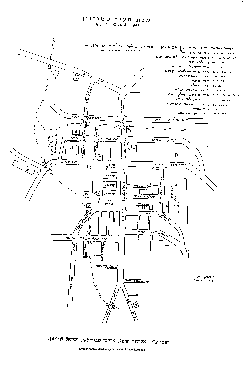
SMORGON'
Belarus

Expedia Maps show Smorgon' and more of the surrounding communities.
A late
19th century map of Belarus in Russian which shows Smorgon
as
In the Smorgon' yizkor book, Smorgon mehoz Vilno; sefer edut ve-zikaron(Smorgonie, District Vilna; memorial book and testimony), Tel Aviv, 1965, Elyezer Karpel, Mordechay Tabouriski & Israel Levinson drew a map in Hebrew and Yiddish of what Smorgon' looked like in 1941. This version, used with permission, has been edited with some English annotations. (Click on the map for an enlarged version, then click your Back icon to return here.)

From 1628 the Jews of Smorgon' paid their taxes to the community administration of Grodno. In 1631 the community of Smorgon' became the center of a province within the frame work of the Council of Lithuania (in Hebrew: Va'ad Midinat Lita.) The autonomous status of the community was confirmed in 1651. In 1765 there were 649 Jews in the community of Smorgon' who paid the poll tax.
The Encyclopeadia Judaica describes the economic life of the 19th century Jewish community there stating, "In 1847 there were 1,621 Jews living in Smorgon. In the 1860s a tanning industry was begun in the town as a result of Jewish initiative. In addition to this, the Jews of the town earned their livelihoods from carpentry, the knitting of socks, the baking of bagels (which were famous throughout Russia), retail trade, and peddling." Some Jewish families worked the land in the nearby Jewish agricultural settlement of Karka.
There were 6,743 Jews living in Smorgon (76% of the population) in 1897. Zionist and Jewish socialist groups were active in the town. On the eve of World War I, there were two battei midrash (houses of study of religious commentary), seven synagogues, three elementary yeshivot (religious schools), and a Jewish hospital there. A section of the town's Jewish population were Habad Hasidim.
In 1915, during World War I, many of the Jews in Smorgon' were sent to the Russian interior. Jewish refugee tanners from Smorgon' founded the tanning industries in Kharkov, Rostov, and Bogorodsk. When Smorgon' reverted to independent Poland after World War I, the Jewish refugees began to return to their destroyed houses. Between the two world wars, a Hebrew Tarbut (Jewish nationalistic) school, a drama circle, sports clubs, Zionist youth circles, and branches of Po'alei Zion (a socialistic and Zionist organization), He-Halutz (promoting pioneering in the Holy Land) and Betar (a more radical Zionist group) were active in the town.
The Red Army occupied Smorgon' in September 1939 until June 1941,
when the Germans occupied the town. In October 1941, some Jews were sent to
the Ghetto in nearby Oshmiany. In the summer of 1942 more were sent to
the Ghetto in Kovno (Kaunas) and shared the fate of that community while the
others were sent to Ponary near Vilna, and were killed there. After
the Second World War, the Jewish community in Smorgon was not
re-established. An association of former residents of Smorgon in
Israel and the U.S.A. was formed.
For another site with photos of the modern city of Smorgon', click
here.
(Click your Back icon to return here.)
Compiled by Batya Olsen
Updated by BMO, March, 1999
Copyright ©
1999, Batya Olsen